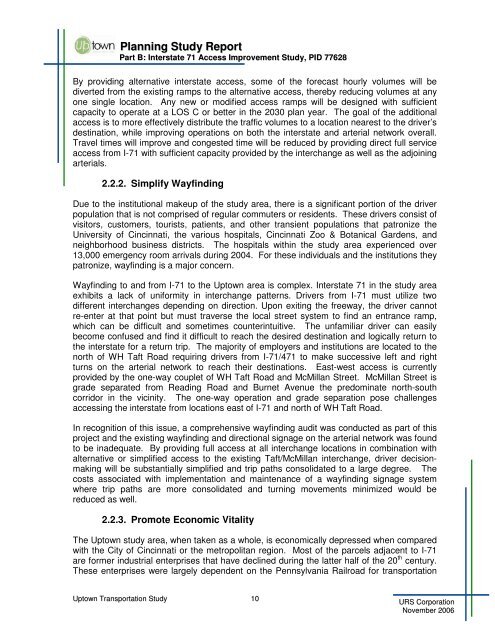Uptown Transportation Study - OKI
Uptown Transportation Study - OKI
Uptown Transportation Study - OKI
You also want an ePaper? Increase the reach of your titles
YUMPU automatically turns print PDFs into web optimized ePapers that Google loves.
Planning <strong>Study</strong> ReportPart B: Interstate 71 Access Improvement <strong>Study</strong>, PID 77628By providing alternative interstate access, some of the forecast hourly volumes will bediverted from the existing ramps to the alternative access, thereby reducing volumes at anyone single location. Any new or modified access ramps will be designed with sufficientcapacity to operate at a LOS C or better in the 2030 plan year. The goal of the additionalaccess is to more effectively distribute the traffic volumes to a location nearest to the driver’sdestination, while improving operations on both the interstate and arterial network overall.Travel times will improve and congested time will be reduced by providing direct full serviceaccess from I-71 with sufficient capacity provided by the interchange as well as the adjoiningarterials.2.2.2. Simplify WayfindingDue to the institutional makeup of the study area, there is a significant portion of the driverpopulation that is not comprised of regular commuters or residents. These drivers consist ofvisitors, customers, tourists, patients, and other transient populations that patronize theUniversity of Cincinnati, the various hospitals, Cincinnati Zoo & Botanical Gardens, andneighborhood business districts. The hospitals within the study area experienced over13,000 emergency room arrivals during 2004. For these individuals and the institutions theypatronize, wayfinding is a major concern.Wayfinding to and from I-71 to the <strong>Uptown</strong> area is complex. Interstate 71 in the study areaexhibits a lack of uniformity in interchange patterns. Drivers from I-71 must utilize twodifferent interchanges depending on direction. Upon exiting the freeway, the driver cannotre-enter at that point but must traverse the local street system to find an entrance ramp,which can be difficult and sometimes counterintuitive. The unfamiliar driver can easilybecome confused and find it difficult to reach the desired destination and logically return tothe interstate for a return trip. The majority of employers and institutions are located to thenorth of WH Taft Road requiring drivers from I-71/471 to make successive left and rightturns on the arterial network to reach their destinations. East-west access is currentlyprovided by the one-way couplet of WH Taft Road and McMillan Street. McMillan Street isgrade separated from Reading Road and Burnet Avenue the predominate north-southcorridor in the vicinity. The one-way operation and grade separation pose challengesaccessing the interstate from locations east of I-71 and north of WH Taft Road.In recognition of this issue, a comprehensive wayfinding audit was conducted as part of thisproject and the existing wayfinding and directional signage on the arterial network was foundto be inadequate. By providing full access at all interchange locations in combination withalternative or simplified access to the existing Taft/McMillan interchange, driver decisionmakingwill be substantially simplified and trip paths consolidated to a large degree. Thecosts associated with implementation and maintenance of a wayfinding signage systemwhere trip paths are more consolidated and turning movements minimized would bereduced as well.2.2.3. Promote Economic VitalityThe <strong>Uptown</strong> study area, when taken as a whole, is economically depressed when comparedwith the City of Cincinnati or the metropolitan region. Most of the parcels adjacent to I-71are former industrial enterprises that have declined during the latter half of the 20 th century.These enterprises were largely dependent on the Pennsylvania Railroad for transportation<strong>Uptown</strong> <strong>Transportation</strong> <strong>Study</strong> 10URS CorporationNovember 2006
















